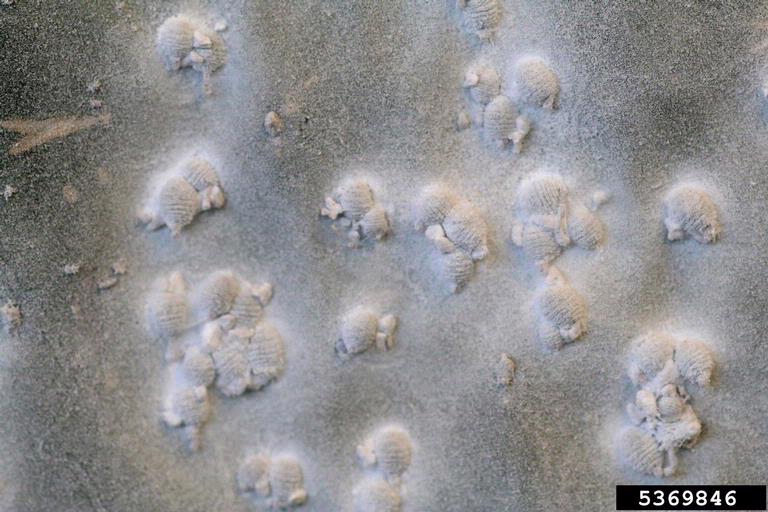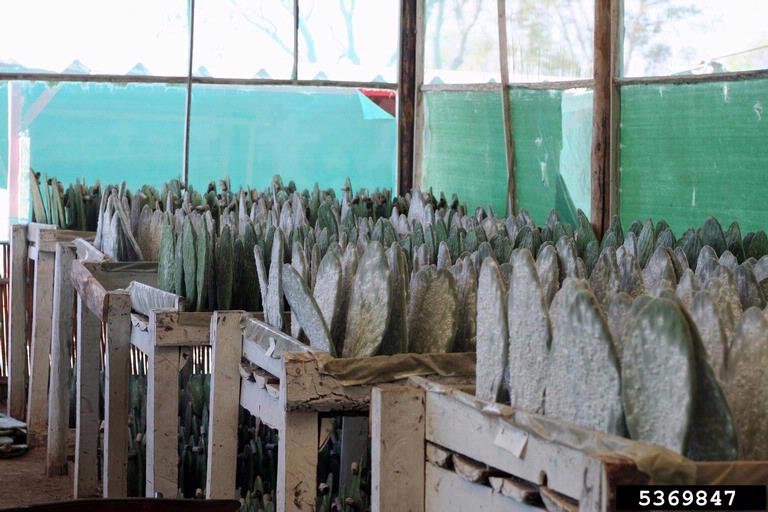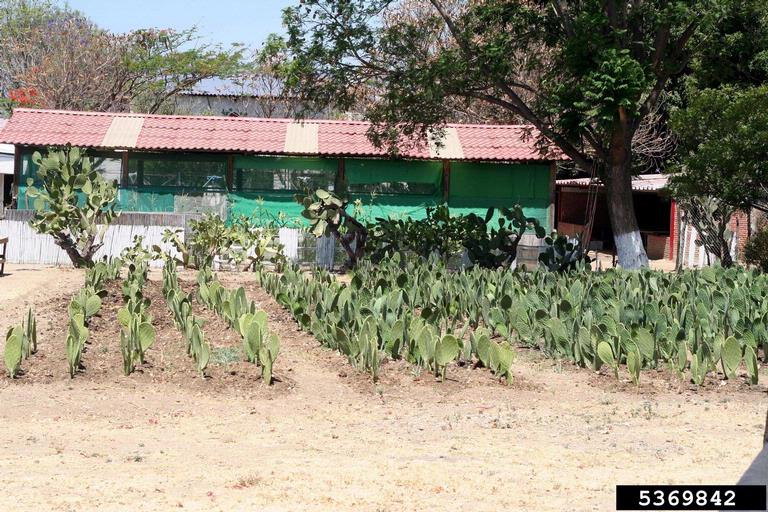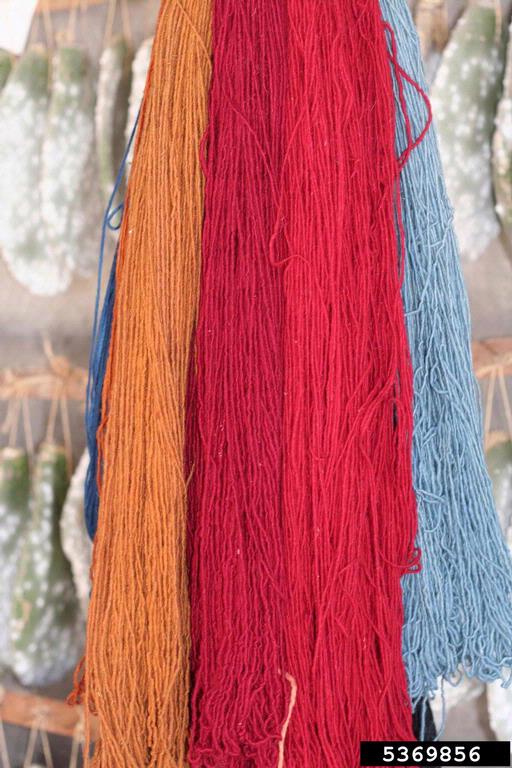 Cochineal Scale - December 28, 2016 Jeff Schalau, Agent, Agriculture & Natural Resources University of Arizona Cooperative Extension, Yavapai County Many of us have prickly pear cactus growing in our landscapes. Prickly pear cacti (Opuntia spp.) are native to the Americas: from South America to the Arctic Circle. They are easy to grow and propagate and make an excellent choice for low water use landscaping in Arizona. They often are colonized by native insects that hide inside conspicuous cottony masses of wax on the surfaces of the stems (pads). For fun, carefully scrape some of wax mass from the plant with a knife and crush it on a piece of paper. If this results in a deep red color, then you have just discovered (and crushed) cochineal scale (Dactylopious spp.). Cochineal scale is native to the New World where it is associated with prickly pear and was used by Aztecs for dying and painting. When Hernán Cortés and his conquistadors entered the Mexico City, with its great market place, they found bales of finely-woven cotton and of delicate yarns spun from rabbit fur, dyed with cochineal. The Aztecs called it nocheztli or grana. Specimens of cochineal were taken to Spain in the 1520s and records show that cloth merchants in Antwerp were buying cochineal in insect and powdered form in Spain by the 1540s. It was also the original dye used to create the British soldier’s “red coat”. Cochineal remained one of the most important sources of red dye until the 1850s, when the first synthetic dyes, called aniline dyes, were produced. Cochineal is still commercially produced in Mexico and India to furnish the permanent brilliant red dye for foods, drinks, cosmetics and artists' colors. The dye made from cochineal is often called carmine or carminic acid. You may want to look for these ingredients on the labels of some of your favorite shampoos, gelatins, fruit juices, candies, and other red-colored products. Cochineal is not found in kosher food products because Jewish dietary laws prohibit the inclusion of insects or their parts in food. Cochineal is one of the most light- and heat-stable and oxidation-resistant of all the natural organic dyes and is even more stable than many synthetic food coloring. I have included several photos with the online edition (see URL below) showing various stages of cochineal dye production and dyed yarn showing the range of colors. What effect do these insects have on prickly pear cacti? Cochineal scale is a sucking insect that uses the cottony wax to shelter female insects (that produce the red dye) and egg masses. The eggs hatch into nymphs (called crawlers) that feed for about three weeks before settling and becoming immobile. The crawler stage is when they spread on and among cactus plants. Once settled, they spin the waxy fiber that shelters them from predators and the weather. Multiple generations are produced each year in warmer areas. While these small insects utilize prickly pear cactus for food, the damage is usually negligible. If a plant is seriously colonized and showing signs of decline, you can prune off the worst pads and discard them (always prune at the joints). Blast the remaining portion of the colonized cactus with water from a high pressure hose nozzle. This should expose and weaken the insects. Then spray the exposed scale with an insecticidal soap. This will minimize harmful effects on beneficial insects. On a philosophical note, I recently saw a pesticide applicator wearing his company’s uniform. Along with the company’s contact information was their motto: “the only good bug is a dead bug.” This is not a good message. Insects are an important part of the world’s food webs and economies. Learn more about insects: observe, appreciate, and understand their habits. Then, if you need to control their numbers once in a while, at least you’ve made your decision based on some information and thoughtful deliberation. Happy Holidays! Follow the Backyard Gardener on Twitter – use the link on the BYG website. If you have other gardening questions, call the Master Gardener help line in the Camp Verde office at 928-554-8992 or e-mail us at verdevalleymg@gmail.com and be sure to include your name, address and phone number. Find past Backyard Gardener columns or provide feedback at the Backyard Gardener web site: http://cals.arizona.edu/yavapai/anr/hort/byg/. Cochineal Photos  Close up of female cochineal scale (Dactylopius coccus) on Indian fig (Opuntia ficus-indica) (Whitney Cranshaw, Colorado State University, Bugwood.org).
Close up of female cochineal scale (Dactylopius coccus) on Indian fig (Opuntia ficus-indica) (Whitney Cranshaw, Colorado State University, Bugwood.org).  Cochineal nursery showing innoculated prickly pear pads on being raised for field planting (Whitney Cranshaw, Colorado State University, Bugwood.org).
Cochineal nursery showing innoculated prickly pear pads on being raised for field planting (Whitney Cranshaw, Colorado State University, Bugwood.org).  A commercial cochineal farm in Oaxaca, Mexico (Whitney Cranshaw, Colorado State University, Bugwood.org).
A commercial cochineal farm in Oaxaca, Mexico (Whitney Cranshaw, Colorado State University, Bugwood.org).  The red and orange yarn has been dyed with cochineal. Changes in pH and certain additives can greatly affect the color of dyed wool (Whitney Cranshaw, Colorado State University, Bugwood.org). Additional Resources Cochineal Scale on Prickly Pear Cactus Texas A & M Agrilife Extension txmg.wpengine.netdna-cdn.com/williamson/files/Cochineal-scale-insect-Aug16.pdf Cochineal Wikipedia en.wikipedia.org/wiki/Cochineal |